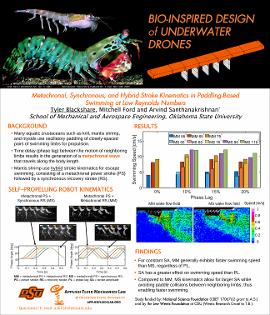| dc.contributor.advisor | Santhanakrishnan, Arvind | |
| dc.contributor.author | Blackshare, Tyler | |
| dc.contributor.author | Ford, Mitchell | |
| dc.contributor.other | Wentz Research Scholars | |
| dc.date.accessioned | 2020-07-07T14:46:26Z | |
| dc.date.available | 2020-07-07T14:46:26Z | |
| dc.date.issued | 2020-04-24 | |
| dc.identifier | oksd_Wentz_2020_blackshare | |
| dc.identifier.citation | Blackshare, T., Ford, M., & Santhanakrishnan, A. (2020, April 24). Bio-inspired design of underwater drones: Metachronal, synchronous, and hybrid stroke kinematics in paddling-based swimming at low Reynolds Numbers. Poster session presented at the Oklahoma State University Wentz Research Scholars Symposium, Stillwater, OK. | |
| dc.identifier.uri | https://hdl.handle.net/11244/324949 | |
| dc.description.abstract | Metachronal paddling is a form of locomotion common in pelagic crustaceans such as krill, in which a series of swimming appendages are stroked in an oscillatory pattern, each appendage with a phase lag compared to the neighboring appendage. In contrast, benthic crustaceans such as mantis shrimp spend most of their time on the seafloor, and perform a hybrid paddling stroke when startled that consists of a metachronal power stroke, followed by a nearly synchronous recovery stroke. We developed a dynamically scaled, self-propelling robotic paddling model, which was programmed to perform three types of idealized paddling strokes (uniformly metachronal, synchronous, hybrid with uniformly metachronal power stroke and synchronous recovery stroke), and a realistic stroke profile tracked from videos of freely swimming peacock mantis shrimp (O. Scyllarus). Using this robotic model, we evaluated the forward swimming performance of these different paddling strategies by measuring thrust, swimming speed, and acceleration generated by each stroke pattern. When stroke amplitude and appendage tip velocity during power stroke are unchanged between idealized stroke patterns, the uniformly metachronal pattern had the highest performance values in each evaluation category, followed by the hybrid pattern, with synchronous paddling showing the lowest values in each category. However, the use of hybrid kinematics allows for the possibility of increasing stroke amplitude, allowing the appendages to sweep longer arcs during power stroke. The effect of increasing stroke amplitude on forward swimming performance of these stroke patterns will be discussed. | |
| dc.description.sponsorship | Lew Wentz Foundation | |
| dc.format | application/pdf | |
| dc.language | en_US | |
| dc.publisher | Oklahoma State University | |
| dc.rights | In the Oklahoma State University Library's institutional repository this paper is made available through the open access principles and the terms of agreement/consent between the author(s) and the publisher. The permission policy on the use, reproduction or distribution of the article falls under fair use for educational, scholarship, and research purposes. Contact Digital Resources and Discovery Services at lib-dls@okstate.edu or 405-744-9161 for further information. | |
| dc.title | Bio-inspired design of underwater drones: Metachronal, synchronous, and hybrid stroke kinematics in paddling-based swimming at low Reynolds Numbers | |
| osu.filename | oksd_Wentz_2020_blackshare.pdf | |
| dc.description.department | Mechanical and Aerospace Engineering | |
| dc.type.genre | Presentation | |
| dc.type.material | Text | |
| dc.subject.keywords | biology | |
| dc.subject.keywords | robotics | |
| dc.subject.keywords | swimming | |
| dc.subject.keywords | underwater | |
| dc.subject.keywords | drones | |
